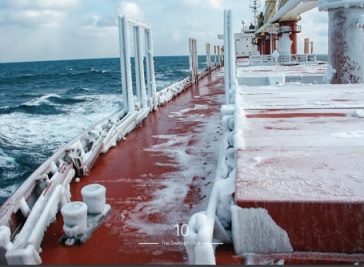Sailing across ocean waters in winter months, especially in the northern hemisphere, is brutal. Severe storms formed one after another, associated with low visibility conditions in long dark hours, offer a navigator his worst nightmare at sea. The most common hazards are sea ice and freezing spray in gale wind force that can cause severe ice accretion on deck. Ice on weather decks also reduces ships' positive stability.
In many circumstances, a shipmaster prefers to sail in lower latitudes expecting favorable weather and found that was not the case. Navigation in cold weather needs some careful consideration, especially where ice is expected to be formed. It is summarized below some necessary check items which might be useful before entering in a cold region. These procedures are only indicative, not exhaustive, and must always be guided by practices of good seamanship.

Ice accretion on deck may damage equipment
and reduce ship stability
-
Confirmation of draining freshwater & seawater pipelines of the vessel and displaying an appropriate notice at pump starting locations
- Confirmation of removing all steam and exhaust pipelines
- Pipelines which can not be drained, are kept circulating & monitored
- Protection of air driven motors & other pneumatic equipment (motors covered, water drained, antifreeze lub oil used)
- Continuous (no-load) operation of steering gear and deck machinery
- Adding antifreeze to emergency generator cooling water
- Using correct grade of hydraulic oil in pumps and other hydraulic equipment (specially designed for cold districts)
- Allowing sufficient ullage space for expansion in all water tanks (Including LifeBoat FW tanks)
- Isolation and draining of bridge front window washing line and surrounding accommodation fresh water pipelines
- Providing crew with appropriate equipment and warm clothing
- Instructions to all personnel instructed on hazards of working in cold areas
- Confirmation of adequate heating in
- Adequate stock of antifreeze (deicing salt) available on board
- Confirmation of operation of bridge de-fogger system, clear view screen heating system and heating system for fog signal motor
- Continuous operation of radar scanners (subject to terminal regulations for tankers)
- Adding deicing salt to ballast sounding pipes to facilitate sounding and avoid cracking
- Confirmation of operation of space heaters for electrical panels and motors
Additionally for Tankers only: - Draining of tank cleaning line / branch lines, steam manifold & heating coils (flush drain)
- Filling of PV breaker with anti-freeze liquid
- Starting of heating steam for deck seal water
- Added anti-freeze liquid to lifeboat cooling water
- Confirm steam trace lines, where fitted and in use have continuous supply of flowing steam and pipeline temperatures frequently monitored
Related articles
Navigating ship in cold areas and necessary deck preparations
Navigation in heavy weather - deck prepaparations
Action by vessels navigating in an area of restricted visibility
Safe anchoring - planning and operational guidance for cargo ships
Anchor watch check item - deck officers guideline
....
How to deal with a damaged anchor?
....
How to recover a lost anchor ?
....
What is stranding ? Investigation of possibility of self-refloating and urgency of danger
....
What are the emergency procedures for loss of anchor and chain?
....
In case of damage to anchor and chain when to claim for '' general average"?
....
Ships arrival in ports - check item prior entry
Ships departure check items
Ships navigation in restricted visibility check items
Rules of ships navigation in restricted visibility
Ships navigation in confined water - matters that require attention
Securing your vessel for sea passage - when to check and what to check
Collecting Information and Data for Passage Planning

Other info pages !
Ships Charterparties Related terms & guideline
Stevedores injury How to prevent injury onboard
Environmental issues How to prevent marine pollution
Cargo & Ballast Handling Safety Guideline
Reefer cargo handling Troubleshoot and countermeasures
DG cargo handling Procedures & Guidelines
Safety in engine room Standard procedures
Questions from user and feedback Read our knowledgebase
Home page

ShipsBusiness.com is merely an informational site about various aspects of ships operation,maintenance procedure,
prevention of pollution and many safety guideline. The procedures explained here are only indicative,
not exhaustive in nature and one must always be guided by practices of good seamanship.
User feedback is
important to update our database. For any comment or suggestions please Contact us
Site Use and Privacy - Read our privacy policy and site use information.
//Home //Terms and conditions of use
Copyright © 2015 www.shipsbusiness.com All rights reserved.




